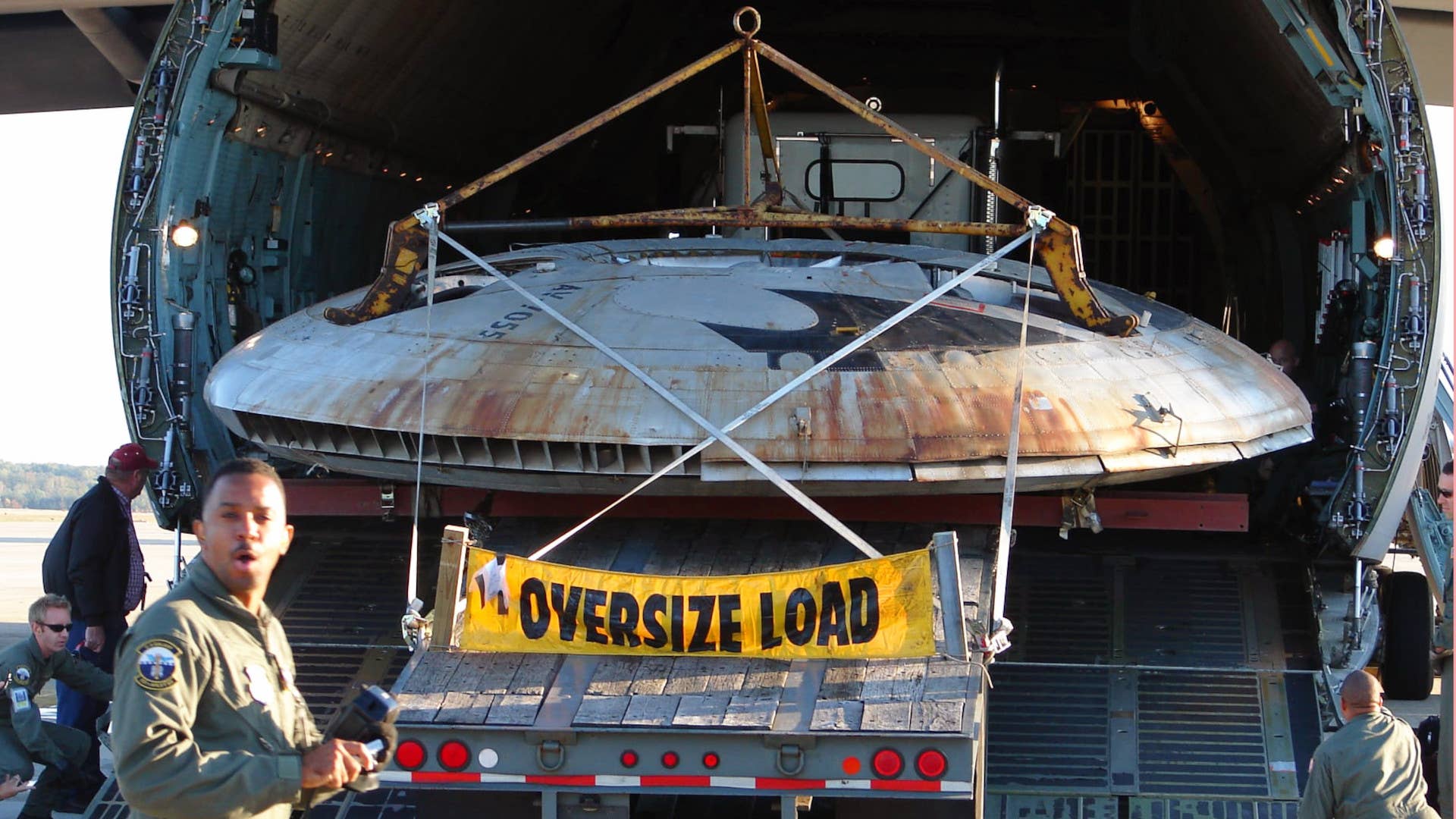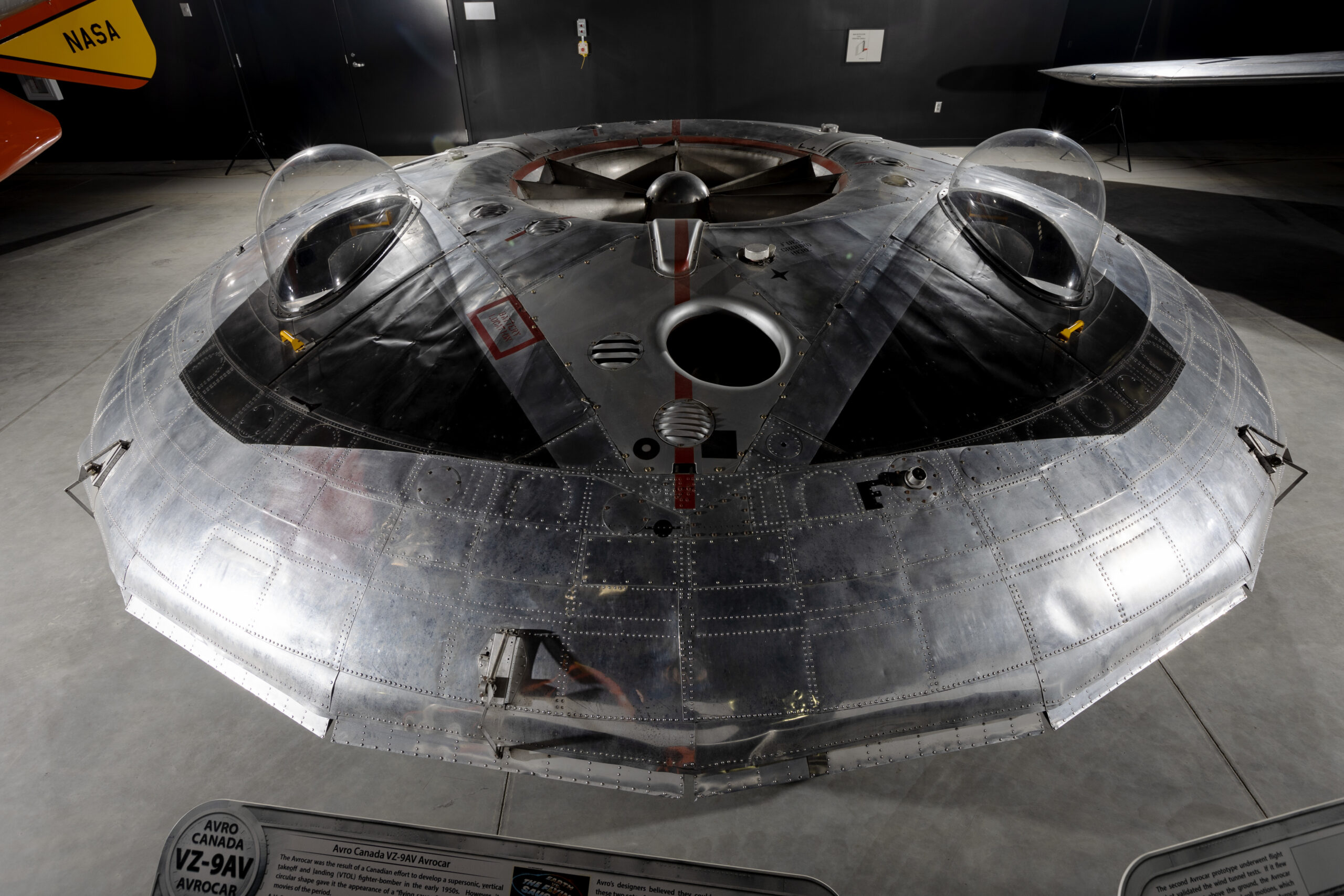
Posted on 12/01/2023 8:35:52 AM PST by Red Badger
It may not be an alien spacecraft, but it is actually a pretty amazing piece of aviation history in that C-5’s hold.
~~~~~~~~~~~~~~~~~~~~~~~~~~~~~~~~~~~~~~~~~~~~~~~~~~~~~~~~~~

ith claims of that the U.S. government has been clandestinely retrieving crashed UFOs for decades making their rounds these days, some images posted by the National Museum of the United States Air Force (NMUSAF) today will definitely raise some eyebrows — at first glance.
The images show a weathered flying saucer being unloaded from the cavernous cargo hold of a C-5 Galaxy at Wright Patterson AFB, the home of the NMUSAF, and also a place that is steeped in UFO lore.

As a side note, the great thing about a C-5 is you can take the whole semi with you, not just its trailer. NMUSAF
~~~~~~~~~~~~~~~~~~~~~~~~~~~~~~~~~~~~~~~~~~~~~~~~~~~~~~~






While the photos look right out of a science fiction movie, and what a notional UFO crash retrieval would probably look like, although with tarps and the cover of darkness added, the craft in question is anything but out of this world.
It's the VZ-9 Avrocar.
The Avrocar traces its origins back to the 1950s when a team at Avro Canada led by John "Jack" Frost started experimenting with aircraft design concepts that could take advantage of the Coandă effect to provide both lift and thrust from a 'turborotor.' At the same time, Canada and many of its NATO allies, fearful of the prospect of an initial wave of Soviet nuclear strikes knocking out key air bases, became very interested in vertical takeoff and landing (VTOL) designs that would be able to operate more flexibly. This is, broadly speaking, something that has more recently come very much back into vogue in the United States in particular for somewhat similar reasons.
VIDEO AT LINK...........
Avro Canada dubbed the effort led by Frost's team as Project Y and it was conducted in great secrecy on what eventually evolved into saucer-like aircraft designs. Frost was subsequently able to garner interest from the U.S. Air Force to continue this work. The Air Force saw the potential to turn the design concept into a supersonic VTOL fighter.

A Project Y mockup, which is not entirely saucer-shaped, but is still very alien-looking. Public Domain via Wikimedia The U.S. Army subsequently entered the picture in the late 1950s. Frost had proposed building a subscale proof-of-concept saucer-shaped aircraft, which also looked like it could possibly meet many of the Army's requirements at the time for a "flying jeep."
The Army's central idea behind the "flying jeep" concept was to blend the capabilities found on 4x4 jeeps and helicopters, which were becoming increasingly commonplace in the U.S. military and other armed forces at that time. Avro Canada subsequently received a contract to build and test two examples of what were dubbed Avrocars and designated VZ-9s. All of this work continued to be done in secret.
"The saucer-shaped craft ... was powered by three Continental J69 turbojet engines. These drove the central fan which provided a peripheral air curtain and ground cushion for VTOL operation," according to an official Army history. "The air intakes for the engine were in the center, while the focusing ring control was located around the bottom edge. The body of the saucer was designed for aerodynamic lift in forward flight, and the craft was intended to have a maximum speed of 300 mph at high altitudes and a range of 1,000 miles."

An artist's depiction of two Army Avrocars armed with recoilless rifles. Public Domain via Wikimedia Testing showed that the performance of the prototype Avrocars left much to be desired, both as a pathway to a larger supersonic fighter and as a flying jeep.
"Tests with scale models at Wright-Patterson AFB, Ohio, indicated that the cushion of air under the Avrocar would become unstable just a few feet off the ground," according to the Air Force's official fact sheet on the VZ-9. "The aircraft would be incapable of reaching supersonic speeds, but the testing went ahead to determine if a suitable aircraft could be developed for the Army."
The first prototype was subsequently sent to NASA's Ames Research Center at Moffett Field in California for wind tunnel testing, which "proved that the aircraft had insufficient control for high-speed flight and was aerodynamically unstable," per the Air Force.
"The second Avrocar prototype underwent flight tests that validated the wind tunnel tests. If it flew more than three feet above the ground, the Avrocar displayed uncontrollable pitch and roll motions, which the Avro engineers called 'hubcapping.'" the Air Force fact sheet adds. "The Avrocar could only reach a maximum speed of 35 mph, and all attempts to end the hubcapping failed."
2 VIDEOs AT LINK................


The Avrocar project was canceled in 1961, but it had already come at a significant cost. The initial contract to build the first prototype was valued at $2 million. The Air Force subsequently added $700,000 more to the project, which came from funds that had originally been approved for the VTOL fighter effort. Avro Canada received another $1.77 million for the second prototype. The final bill, approximately $4.47 million, is equivalent to around $47 million in today's dollars when adjusted for inflation.
Though the VZ-9 was itself a failure, it is credited with having a significant influence on subsequent VTOL and 'flying car' designs.
The Army subsequently put the second prototype on public display outside, where its condition deteriorated. It subsequently passed to the U.S. Army Transportation Museum at Fort Eustis in Virginia, which then began restoring it for display indoors.
The first prototype that had been sent to NASA's Ames facility stayed there until 1966, at which time it was donated to the Smithsonian's National Air and Space Museum. It remained in storage for four decades before it was put on public display at the Museum's annex, also known as the Steven F. Udvar-Hazy Center, which opened in 2003. Four years later, it was sent on loan to the National Museum of the United States Air Force – via the C-5 seen in the photos.
The Aviocar was subsequently lovingly restored and now the USAF's flying saucer that wasn't meant to be sits on display in the Cold War hall at the sprawling museum.
Looking back, it's fascinating to ponder what the Aviocar could have been capable of using modern fly-by-wire flight controls and materials.

What the heck izzat?............
Speaking of wormholes ...
😉🤦♂️🤷♂️.............................
If you rack up enough Hilton Honors Points, you get a very special reward.
Look at what happens today when people try to stretch the current limits: Musk test launches the largest rocket known to man and it (expectedly) fails. Even the folks around here start Pooh Pooh the man and the process.
There is no way I would test anything in public these days. The world expects perfection, every time, all the time—and the people setting those expectations have mostly never accomplished anything on their own. Who needs that?
The dreamers and the engineers ARE out there. They just fail in private these days.
A double shot of penicillin?
You’re not my Supervisor!!!
Amen, brother!
;’}
I had a fellow aircraft worker almost turn violent at my mere suggestion ( back in the mid 90s ) that we won’t see hardly any new aircraft prototypes like we used to due to tight budgets and computer designs. He was deeply upset that anybody would suggest such a thing. I said there will tons of planes in the future but only flying on CADM programs with just about a handful per decade joining us in real life. I see where I may have overestimated that. I should have bet him money. The F-22 and F-35 had already came out.
-Indeed. And then there were the “X” planes ... X-1 thru 5, X-13, X-14, and X-15.-
And the bombers;
A-3 Sky Warrior
B-47 Stratojet
B-57 Canberra
B-58 Hustler
YB-60
And of course the B-52 BUFF. 742 were built and 58 still in service (there is an additional 18 in reserve). The USAF expects the B-52 to be in service into the 2050’s. Amazing!
True this. I won’t question the ability of modern technology to fix old problems but I doubt we’ll be seeing any armed flying saucers anytime soon.
At least I don’t think so 🤔
I don’t want to crap on today’s planes; from F-15 to F22 they’re great ... but there’s a cultural loss of boldness as well. The F22 is 1990s to early 2000s technology.
Armed or not, I’d take a ride on a jet powered, fly-by-wire flying saucer just for the sheer coolness of it.
Geez, I forgot the B-36 Peacemaker.


At least not ours...
Speaking of which...
What do you call it when you see a flying saucer or a Bigfoot again?
Taking nominations for the next Undead Thread. If it comes from a ZOT thread from the Viking Kitties they get 1st dibs at the carcass of the troll and an extra helping of heavy cream the next morning.
Timberrattler and amnestynone felt the ZOT on that thread and I am sure The Undead squeezed and stomped all the goody outa those yahoos!




Disclaimer: Opinions posted on Free Republic are those of the individual posters and do not necessarily represent the opinion of Free Republic or its management. All materials posted herein are protected by copyright law and the exemption for fair use of copyrighted works.